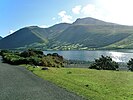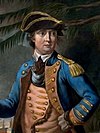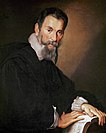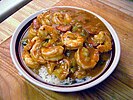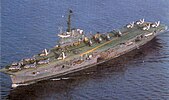Wikipedia:Today's featured article/September 2017
| << | Today's featured articles for September 2017 | >> | ||||
|---|---|---|---|---|---|---|
| Su | Mo | Tu | We | Th | Fr | Sa |
| 1 | 2 | |||||
| 3 | 4 | 5 | 6 | 7 | 8 | 9 |
| 10 | 11 | 12 | 13 | 14 | 15 | 16 |
| 17 | 18 | 19 | 20 | 21 | 22 | 23 |
| 24 | 25 | 26 | 27 | 28 | 29 | 30 |
September 1
King's Highway 71 is a provincially maintained highway in the Canadian province of Ontario. Part of the Trans-Canada Highway, the 194-kilometre (121 mi) route travels west from the Fort Frances-International Falls International Bridge in Fort Frances, concurrently with Highway 11, for 40 kilometres (25 mi). At Chapple, Highway 71 branches from Highway 11, travelling 154 kilometres (96 mi) north to a junction with Highway 17 just east of Kenora. The concurrent portion of the highway follows the Cloverleaf Trail, which was completed by the end of the 1880s and improved over the next several decades. The portion between Highway 11 and Highway 17 follows the Heenan Highway, which connects the Rainy River region with Kenora and the remainder of Ontario's road network; before its opening the area was accessible only via the United States. Both highways were incorporated into the provincial highway system in 1937 following the merger of the Department of Highways and the Department of Northern Development. (Full article...)
September 2
Steller's sea cow (Hydrodamalis gigas) was a sirenian that lived until 1768 around the Commander Islands in the Bering Sea, named for the naturalist Georg Wilhelm Steller. He discovered the species in 1741 on Vitus Bering's Great Northern Expedition, when the crew was shipwrecked on Bering Island, and described it in The Beasts of the Sea, published after his death. The sea cow reached weights of 8–10 metric tons (8.8–11.0 short tons) and lengths of up to 9 metres (30 ft). Its closest living relative, the 3-metre-long (9.8 ft) dugong, is the sole surviving member of its family, Dugongidae. It had a thicker layer of blubber than other sirenians, and its tail was forked like those of whales and other cetaceans. Instead of teeth, the sea cow had an array of white bristles on its upper lip and two keratinous mouth plates for chewing. It fed mainly on kelp, and communicated via sighs and snorting sounds. There is evidence that it was a monogamous and social animal, living in small family groups and raising its young. Twenty-seven years after its discovery, the slow-moving species had been hunted to extinction for its meat, fat, and hide. (Full article...)
September 3
Percy Chapman (3 September 1900 – 16 September 1961) captained the England cricket team between 1926 and 1931. Representing the Cambridge cricket team in 1920, he once scored centuries against Oxford and in the Gentlemen v Players match within the space of a week. Chapman made his Test debut in 1924, although he had yet to play County Cricket. A left-handed batsman, he went on to play 26 Test matches for England. After he took over from Arthur Carr as captain in 1926, England defeated Australia for the first time since 1912. He achieved victory in his first nine matches in charge but lost two and drew six of his remaining games. An amateur cricketer, Chapman played first-class cricket for Kent, eventually as captain. He had a respectable batting record, could score runs quickly, and was popular with spectators. Contemporaries rated him highly as a fielder. Although opinions were divided on his tactical ability as a captain, he was seen as an inspirational leader. Chapman's success gave him access to fashionable society for a time, but in the 1930s, his health and cricketing form declined. For the rest of his life, he suffered from alcoholism. (Full article...)
September 4
Northern England roughly coincides with the statistical regions of North East England, North West England and Yorkshire and the Humber, which have a combined population of 14.9 million as of the 2011 Census. It contains much of England's national parkland as well as the conurbations of Greater Manchester, Merseyside, Teesside, Tyneside, Wearside, and South and West Yorkshire. Until the unification of Britain under the Stuarts, the area experienced Anglo-Scottish border fighting. Many of the innovations of the Industrial Revolution began in Northern England, and its cities were the crucibles of many of the political changes that accompanied this social upheaval, from trade unionism to Manchester Capitalism. In the late 19th and early 20th centuries, the economy of the North was dominated by heavy industry such as weaving, shipbuilding, steelmaking and mining, but deindustrialisation in the late 20th century hit hard. Urban renewal projects and the transition to a service economy have resulted in strong economic growth in some areas, but a North–South divide remains in both the economy and the culture of England. (Full article...)
September 5
Oxygen is a chemical element with symbol O and atomic number 8. A member of the chalcogen group on the periodic table, it is a highly reactive nonmetal and oxidizing agent that forms oxides with most elements as well as other compounds. By mass, oxygen is the most abundant element in the Earth's crust and the third-most abundant in the universe, after hydrogen and helium. Two atoms of the element can bind to form dioxygen, a colorless and odorless gas that constitutes 20.8% of the Earth's atmosphere, produced by photosynthesis from water and carbon dioxide. Oxygen is present in water, proteins, nucleic acids, carbohydrates, and fats. Its name was coined in 1777 by Antoine Lavoisier, whose experiments helped to discredit the then-popular phlogiston theory of combustion and corrosion. Common uses of oxygen include residential heating, internal combustion engines, production of steel, plastics and textiles, brazing, welding and cutting of steels and other metals, rocket propellant, oxygen therapy, and life support systems in aircraft, submarines, spaceflight and diving. (Full article...)
September 6
The 2014 Lamar Hunt U.S. Open Cup Final was the 101st edition of the oldest competition in American soccer, played on September 6, 2014, at PPL Park (pictured) in Chester, Pennsylvania. Seattle Sounders FC won the match before a crowd of 15,256, defeating the Philadelphia Union. Philadelphia and Seattle both play in the top tier of American soccer, Major League Soccer, and bypassed the initial stages of the tournament with entries into the third round of play. The Sounders were in the midst of a Supporters' Shield-winning regular season, while the Union's start was so poor that their coach was replaced a week prior to their first game in the competition. The Union's Maurice Edu gave his team the lead with a goal in the first half, but the Sounders equalized with a second half strike by Chad Barrett, and the match went into extra time. Clint Dempsey took the lead for Seattle, and Obafemi Martins sealed the victory with a late goal. Seattle earned a $250,000 cash prize, as well as a berth in the 2015–16 CONCACAF Champions League. (Full article...)
September 7
Corvus is a small constellation in the Southern Celestial Hemisphere. Its name means "raven" in Latin. In the Babylonian star catalogues dating from at least 1100 BCE, it was called the Babylonian Raven. One of the 48 constellations listed by the 2nd-century astronomer Ptolemy, it depicts a raven, a bird associated with stories about the god Apollo, perched on the back of Hydra the water snake. It is also bordered by the constellations Virgo and Crater. Its four brightest stars, Gamma, Delta, Epsilon, and Beta Corvi, form a distinctive quadrilateral in the night sky. With an apparent magnitude of 2.59, Gamma Corvi—also known as Gienah—is the brightest star in the constellation. It is an aging blue giant around four times as massive as the Sun. The young star Eta Corvi has been found to have two debris disks. Three star systems have exoplanets, and a fourth planetary system is unconfirmed. TV Corvi is a dwarf nova—a white dwarf and brown dwarf in very close orbit. (Full article...)
September 8
Peter Martyr Vermigli (8 September 1499 – 12 November 1562) was an Italian-born Reformed theologian. His early work as a reformer in Catholic Italy and decision to flee for Protestant northern Europe influenced many other Italians to convert and flee as well. English reformer Thomas Cranmer invited him to leave a teaching position at Strasbourg in Alsace to take an influential post at the University of Oxford, where he defended his Eucharistic beliefs against Catholic proponents of transubstantiation in a public disputation. He influenced the Edwardian Reformation, including the Eucharistic service of the 1552 Book of Common Prayer. Forced to leave England on the accession of the Catholic Queen Mary I, he eventually settled in Reformed Zürich, where he taught until his death. He was considered an authority on the Eucharist among the Reformed churches, and engaged in controversies on the subject by writing treatises. His Loci Communes, a compilation of excerpts from his biblical commentaries organized by the topics of systematic theology, became a standard Reformed theological textbook. (Full article...)
September 9
The California Diamond Jubilee half dollar was a US commemorative fifty cent piece, struck at the San Francisco Mint in 1925. The San Francisco Citizens' Committee wanted to use coin sales to fund a celebration of the 75th anniversary of California statehood. A California congressman attached the authorization to another coinage bill, which was approved in early 1925. Designs by sculptor Jo Mora met a hostile reception at the Commission of Fine Arts, but the Citizens' Committee would not change them, and they were approved. The coin has been widely praised for its beauty; the obverse depicts a Gold Rush-era prospector, and the reverse is an adaptation of the Flag of California, showing a grizzly bear. Some 150,000 of the authorized mintage of 300,000 coins were struck in August 1925 in San Francisco. They were offered for sale the following month, but nearly half went unsold, and were later melted. The coin is catalogued at between $200 and $1,300, though exceptional specimens have sold for more. (Full article...)
September 10
The North Eastern Railway War Memorial is a First World War memorial in York in northern England designed by Sir Edwin Lutyens. It commemorates employees of the North Eastern Railway (NER) who were killed while serving in the First World War. The NER, one of the largest employers in the north of England, released over 18,000 of its employees to serve in the armed forces. By the end of the war, 2,236 men from the company had died on military service overseas; others were killed at home by bombardments of east coast ports, including a raid on Scarborough, Hartlepool and Whitby, and three Zeppelin raids on York. After the war, thousands of memorials were built across Britain. Among the most prominent designers of memorials was Lutyens, described by Historic England as "the leading English architect of his generation". The NER memorial, unveiled in 1924, consists of a 54-foot-high (16-metre) obelisk rising from the rear portion of a three-sided screen wall. The wall forms a recess in which stands Lutyens' characteristic Stone of Remembrance. The memorial is a grade II* listed building. (Full article...)
September 11
Benedict Arnold led an expedition early in the American Revolutionary War from Cambridge, Massachusetts, through the wilderness of what is now Maine to the gates of Quebec City, setting out on September 11, 1775. Colonel Arnold's force of 1,100 Continental Army troops was part of a two-pronged invasion of the British Province of Quebec, along with Richard Montgomery's expedition pushing north from Lake Champlain. By the time Arnold reached the French settlements above the Saint Lawrence River in November, his force was reduced to 600 starving men. They had traveled about 350 miles (560 km) through poorly charted wilderness, twice the distance they had expected to cover. Assisted by the local French-speaking Canadiens, Arnold's troops crossed the Saint Lawrence on November 13 and 14 and attempted to put Quebec City under siege. Failing in this, they withdrew until Montgomery arrived to lead an unsuccessful attack on the city. Arnold received a promotion to brigadier general. His route through northern Maine has been listed on the National Register of Historic Places as the Arnold Trail to Quebec. (Full article...)
Part of the Canadian campaign of 1775 featured topic.
September 12
Steve Biko (18 December 1946 – 12 September 1977) was a South African Xhosa anti-apartheid activist. Fighting racial segregation and white-minority rule in South Africa, Biko was at the forefront of the grassroots Black Consciousness Movement during the late 1960s and 1970s. Frustrated by the domination of white liberals in the anti-apartheid movement, he became a leading figure in the creation of the South African Students' Organisation in 1968. An African nationalist and African socialist, he was influenced by Frantz Fanon and the African-American Black Power movement. He promoted its slogan "black is beautiful", believing that black people needed to rid themselves of any sense of racial inferiority. In 1972, he helped found the Black People's Convention to spread these ideas among the wider population. Though the government banned Biko in 1973, he remained politically active. He was arrested in August 1977 and severely beaten by State security officers, resulting in his death. One of the earliest icons of the movement against apartheid, Biko is regarded as a political martyr. (Full article...)
September 13
Si Ronda is a 1930 silent film from the Dutch East Indies, directed by Lie Tek Swie and starring Bachtiar Effendi (pictured). It was adapted from a lenong (a Betawi oral tradition similar to a stage play) that was popular with ethnic Chinese and native audiences of the time. Adaptations of the genre, manifested as bandit films, appeared in domestic cinema following the release of Si Tjonat by Batavia Motion Picture in 1929. The Ronda stories follow the Betawi bandit of the same name, who is skilled at silat (traditional martial arts) and reputed to take from the rich to give to the poor. The Indonesian film scholar Misbach Yusa Biran suggests that Ronda was selected for adaptation because of its action sequences. In the domestic cinema, such sequences had generally been inspired by American works and been well received by audiences. The production, now thought lost, was one of a series of martial arts films released between 1929 and 1931. Si Ronda received little coverage in the media upon its release. A second adaptation of the tale, Si Ronda Macan Betawi, was made in 1978. (Full article...)
September 14
Seven of Claudio Monteverdi's operas are lost, apart from a few fragments, out of ten the Italian composer wrote in whole or in part between 1607 and 1643. A few librettos from these early baroque works have survived. Opera as a genre emerged during Monteverdi's creative lifetime, and he became a principal exponent of this new form, first at the Mantuan court and later as director of music at St Mark's Basilica in Venice. The loss of these works, written during a critical period of early opera history, has been much regretted by historians and musicologists, but reflects the habit of the times, when stage music was thought to have little relevance beyond its initial performance and often vanished quickly. Contemporary documents, including many letters written by Monteverdi, have provided most of the available information on the lost works, and have established that four of them were completed and performed in the composer's lifetime. Of the little music that has survived, the lamento from L'Arianna (1608) is frequently performed. (Full article...)
September 15

Eve is an American television sitcom, created by Meg DeLoatch, that originally aired on United Paramount Network from September 15, 2003, to May 11, 2006. It features an ensemble cast with Eve (pictured), Jason George, Ali Landry, Natalie Desselle-Reid, Brian Hooks, and Sean Maguire as six friends attempting to navigate relationships with the opposite sex. Produced by The Greenblatt-Janollari Studio, Mega Diva Inc., and Warner Bros. Television, the series was developed as a vehicle for Eve under the working title The Opposite Sex, and was targeted to younger audiences. After being picked up, the show was renamed Eve to attract the rapper's fans. The series was set in Miami, but filmed at Sunset Gower Studios in Hollywood, Los Angeles. Eve suffered from low viewership in spite of high ratings among young Hispanic women. The cancellations of this series and other black sitcoms were criticized by media outlets for reducing representation of African American characters and the number of roles for African American actors on television. Critical response to Eve was mixed, but the show and Eve received several award nominations. (Full article...)
September 16
Gumbo is a stew or soup associated with southern Louisiana since the 18th century. It consists primarily of meat or shellfish, a strongly flavored stock, a thickener, celery, bell peppers, and onions. The dish likely derived its name from either the Bantu word for okra (ki ngombo) or the Choctaw word for filé (kombo). Several varieties exist; Creole gumbo generally contains shellfish and tomatoes, while Cajun gumbo is generally based on a dark roux and is spicier, with either shellfish or fowl. Sausage or ham are often added to gumbos. After the base is prepared, the vegetables are cooked down, and meat is added. The dish simmers for a minimum of three hours, with shellfish and some spices added near the end. It is traditionally served over rice. The dish combines ingredients and culinary practices of several cultures, including French, Spanish, German, West African, and Choctaw. It was first described in 1802, and was listed in various cookbooks in the latter half of the 19th century. Chef Paul Prudhomme's popularity in the 1980s spurred further interest in gumbo. The dish is the official cuisine of Louisiana. (Full article...)
September 17
More than a thousand people developed Grand Theft Auto V, an action-adventure video game. Rockstar Games released the game on 17 September 2013 for PlayStation 3 and Xbox 360, on 18 November 2014 for PlayStation 4 and Xbox One, and on 14 April 2015 for Microsoft Windows, as the fifteenth entry in the Grand Theft Auto series. Development began soon after Grand Theft Auto IV's release and was led by Rockstar North's core 360-person team, who considered the game a spiritual successor to many of their previous projects like Red Dead Redemption and Max Payne 3. Its release date, though subject to several delays, was widely anticipated. Much of the development time was spent creating the game's open world, modelled on Southern California and Los Angeles. For the first time in the series, players control three protagonists throughout the single-player mode; the team found that these changes altered the gameplay and narrative devices. The game features an original score, composed over several years by a team of five music producers. Its re-release added a first-person view option along with the traditional third-person view. (Full article...)
September 18
Morchella rufobrunnea, the blushing morel, is a sac fungus in the family Morchellaceae. A prized edible species, the fungus was first described in 1998 by mycologists Gastón Guzmán and Fidel Tapia from collections made in Veracruz, Mexico. Several DNA studies have suggested that it is common in the West Coast of the United States, Israel, Australia, and Cyprus. It grows in disturbed soil or in woodchips used in landscaping, and occasionally under olive trees (Olea europaea) in the Mediterranean Basin. Young fruit bodies have conical, grayish caps covered with pale ridges and dark pits; mature specimens are yellowish to ochraceous-buff, and grow to a height of 9.0–15.5 cm (3.5–6.1 in). M. rufobrunnea differs from other Morchella species in its urban or suburban habitat preferences, the color and form of the fruit body, the lack of a sinus at the attachment of the cap with the stalk, the length of the pits on the surface, and a brownish-orange or pinkish bruising reaction. A process to cultivate morels now known to be M. rufobrunnea was described and patented in the 1980s. (Full article...)
September 19
Egyptian temples were built to commemorate the pharaohs and to support the central functions of their religion: giving offerings to the gods, reenacting their mythological interactions through festivals, and warding off the forces of chaos. Rituals, it was believed, invoked the divine presence, sustained the god, and enabled it to continue to uphold the divine order of the universe. Temples were important religious sites for all classes of Egyptians even though most people were forbidden from entering their most sacred areas. They are among the largest and most enduring examples of Egyptian architecture, with their elements arranged and decorated according to complex patterns of religious symbolism. A large temple could own sizable tracts of land and employ thousands of laymen to supply its needs. Some temples, such as Abu Simbel, have become tourist attractions that contribute significantly to the modern Egyptian economy. Egyptologists continue to study the surviving temples for their invaluable sources of information about ancient Egyptian society. (Full article...)
September 20
Planet Stories was an American pulp science fiction magazine, published by Fiction House between 1939 and 1955. It featured adventures in space and on other planets, and was initially focused on a young readership. Malcolm Reiss was editor or editor-in-chief for all of its 71 issues. It was launched at the same time as Fiction House's more successful Planet Comics. Almost every issue's cover emphasized scantily clad damsels in distress or alien princesses. Planet Stories did not pay well enough to regularly attract the leading science fiction writers of the day, but did on occasion manage to obtain work from well-known names including Isaac Asimov, Clifford Simak, and Philip K. Dick. The two writers most identified with the magazine are Leigh Brackett and Ray Bradbury, both of whom set many of their stories on a romanticized version of Mars that owed much to the depiction of Barsoom in the works of Edgar Rice Burroughs. Bradbury contributed an early story in his Martian Chronicles sequence, and Brackett authored a series of adventures featuring Eric John Stark. (Full article...)
September 21
The Blue Flame is a four-act play written by George V. Hobart and John Willard, who revised an earlier version by Leta Vance Nicholson. In 1920, producer Albert H. Woods staged the play on Broadway and on tour across the United States. Ruth Gordon, the main character, is a religious young woman who dies and is revived by her scientist fiancé as a soulless femme fatale. She seduces several men and involves them in crimes, including drug use and murder. In the final act, her death and resurrection are revealed to be a dream. The production starred Theda Bara (pictured), a popular silent film actress who was known for playing similar roles in movies. Critics panned the play, ridiculing the plot, the dialog, and Bara's acting. Theater historian Ward Morehouse called it "one of the worst plays ever written". Bara's movie fame drew large crowds to theaters, and the play was a commercial success, breaking attendance records at some venues. Ruth Gordon was Bara's only Broadway role, and The Blue Flame was one of her last professional acting projects. (Full article...)
September 22
INS Vikrant (from Sanskrit for "courageous") was a Majestic-class aircraft carrier of the Indian Navy. The ship was laid down as HMS Hercules for the British Royal Navy during World War II and launched on 22 September 1945, but construction was put on hold when the war ended. India purchased the incomplete carrier in 1957, and construction was completed in 1961. Vikrant was commissioned as the first aircraft carrier of the Indian Navy and played a key role in enforcing the naval blockade of East Pakistan during the Indo-Pakistan War of 1971. In its later years, the ship underwent major refits to embark modern aircraft, before being decommissioned in January 1997. Vikrant was preserved as a museum ship in Cuffe Parade, Mumbai, until 2012. The ship was sold through an online auction in January 2014 and scrapped in November 2014 after final clearance from the Supreme Court. The Indian Navy is currently constructing its first home-built carrier, also named INS Vikrant, scheduled to be commissioned by the end of 2018. (Full article...)
September 23
Literary Hall is a brick library building and museum in Romney, West Virginia, built in 1869 and 1870 by the Romney Literary Society. Founded in 1819, the society was the first literary organization of its kind in the present-day state of West Virginia, and one of the first in the United States. In 1846, the society constructed a building which housed the Romney Classical Institute and its library. During the Civil War the library's contents were plundered by Union Army forces, and many of its 3,000 volumes were scattered or destroyed. The society transferred ownership of its Romney Classical Institute campus to the West Virginia Schools for the Deaf and Blind in 1870 and in that year completed Literary Hall, where the society reconstituted its library collection and revived its literary activities. The Romney Literary Society's last meeting was held there in 1886. In 1979 the hall was placed on the National Register of Historic Places. Its basic design incorporates Federal and Greek Revival styles along with Victorian details. (Full article...)
September 24
The Downtown Seattle Transit Tunnel is a public transit tunnel for buses and light rail trains in Seattle, Washington, in the United States. It runs north–south through Downtown Seattle, connecting five stations on 3rd Avenue and Pine Street. It is the busiest section of Sound Transit's Link light rail network, with an average of over 10,000 weekday train boardings at the four stations served by light rail. The $469 million tunnel was planned in the late 1970s and built between 1987 and 1990, using tunnel boring machines and cut-and-cover excavation. Between 1990 and 2004, the tunnel was exclusively used by dual-mode buses that ran on overhead wires; they were later replaced with hybrid electric buses using batteries within the tunnel. After a two-year renovation, the tunnel reopened on September 24, 2007, and light rail service began in July 2009, sharing the platforms with existing buses. Planned expansion of the light rail system, along with the closure of one station, will necessitate the removal of buses from the tunnel by 2019. (Full article...)
September 25
Catherine Zeta-Jones (born 25 September 1969) is a film and stage actress. Raised in Swansea, Wales, she studied musical theatre at the Arts Educational Schools, London, and made her adult stage breakthrough with a leading role in 1987 in 42nd Street. She found great success as a regular in the British television series The Darling Buds of May (1991–93). Dismayed at being typecast as the token pretty girl in British films, Zeta-Jones relocated to Los Angeles. Critics praised her portrayal of a vengeful pregnant woman in Traffic (2000) and a murderous singer in the musical film Chicago (2002), winning her the Academy Award for Best Supporting Actress. She continued to star in high-profile films for much of the 2000s, including the black comedy Intolerable Cruelty (2003), the heist film Ocean's Twelve (2004), the comedy The Terminal (2004), and the romantic comedy No Reservations (2007). During a decrease in workload, she returned to the stage and portrayed an ageing actress in A Little Night Music (2009), winning the Tony Award for Best Actress. (Full article...)
September 26
St Botolph's Church is an Anglican place of worship in the village of Quarrington, part of the civil parish of Sleaford in Lincolnshire, England. By the time Domesday Book was compiled in 1086, a church in Quarrington was part of Ramsey Abbey's fee, and around 1165 it was granted to Haverholme Priory. The right to present the rector was claimed by the Abbey in the 13th century, by the Bishop of Lincoln in the early 16th century, and by Robert Carre and his descendants after Carre acquired a manor at Quarrington. The oldest parts of the current building date to the 13th century, although substantial rebuilding took place over the following century. Renovations followed and the local architect Charles Kirk the Younger carried out restoration work in 1862 and 1863, when he added a chancel in his parents' memory. The church consists of a tower and spire with a nave and north aisle spanning eastwards to the chancel. With capacity for 124 people, the church serves the ecclesiastic parish of Quarrington with Old Sleaford. Recognised for its age and tracery, the church has been designated a grade II* listed building. (Full article...)
September 27
The spotted green pigeon is a species of pigeon that is most likely extinct. It was first mentioned and described in 1783 by John Latham, who claimed to have seen two specimens and a drawing depicting the bird. Today, the species is only known from a specimen kept in World Museum, Liverpool. Overlooked for much of the 20th century, it was only recognised as a valid extinct species by the IUCN Red List in 2008. In 2014 a genetic study confirmed it as a distinct species related to the Nicobar pigeon, and showed that the two were the closest relatives of the extinct dodo and Rodrigues solitaire. The remaining specimen is 32 cm (12.5 in) long, and has very dark, brownish plumage with a green gloss. The neck-feathers are elongated, and most of the feathers on the upperparts and wings have a yellowish spot on their tips. It has a black bill with a yellow tip, and the end of the tail has a pale band. It has relatively short legs and long wings. It may have been native to an island somewhere in the South Pacific Ocean or the Indian Ocean, and it has been suggested that a bird referred to in 1928 as titi by Tahitian islanders was this bird. (Full article...)
September 28
Gods' Man is a wordless novel by American artist Lynd Ward (1905–1985) published in 1929. In 139 captionless woodblock prints it tells the Faustian story of an artist who signs away his soul for a magic paintbrush. It was the first American wordless novel, and is seen as a precursor of, and influence on, the graphic novel. Ward first encountered the wordless novel with Frans Masereel's The Sun (1919) while studying art in Germany in 1926. He returned to the United States in 1927 and established a career for himself as an illustrator. He found Otto Nückel's wordless novel Destiny (1926) in New York City, and it inspired him to create a similar work. Gods' Man appeared a week before the Wall Street Crash of 1929; it nevertheless enjoyed strong sales and remains the best-selling American wordless novel. Its success inspired other Americans to experiment with the medium, including cartoonist Milt Gross, who parodied it in He Done Her Wrong (1930). In the 1970s Ward's example inspired cartoonists Art Spiegelman and Will Eisner to create their first graphic novels. (Full article...)
September 29
Michael Francis Egan (September 29, 1761 – July 22, 1814) was a prelate of the Roman Catholic Church. Born in Ireland, he joined the Franciscan Order at a young age. He was ordained a priest, probably in Prague, in 1785 or 1786. He advanced rapidly to positions of responsibility in the Franciscan order, becoming custos (guardian) in the province of Munster in Ireland, then at the Pontifical College at the home of Irish Franciscans in Rome, and later at Ennis in Ireland. Egan arrived in the United States in January 1802 to serve as an assistant pastor near Lancaster, Pennsylvania. His reputation as a gifted preacher secured him a position in 1803 as a pastor at St. Mary's Church in Philadelphia. In 1808, he was appointed the first Bishop of Philadelphia, holding that position until his death in 1814. His tenure as bishop saw the construction of new churches and the expansion of the Catholic Church membership in his diocese, but much of his time was consumed by disputes with the lay trustees of St. Mary's Church. (Full article...)
September 30
Washington v. Texas (1967) is a US Supreme Court case about the right of criminal defendants to have witnesses testify on their behalf. The Court decided that the Compulsory Process Clause of the Sixth Amendment to the Constitution applied in state courts as well as federal courts. At his trial Jackie Washington had attempted to call his co-defendant as a witness but was blocked because state law prevented co-defendants from testifying for each other, under the theory that they might lie for each other on the stand. The Supreme Court reasoned that the Due Process Clause of the Fourteenth Amendment gives defendants the right to fair proceedings, including the right to compel defense witnesses to testify. In previous cases, the Supreme Court had ruled that the Fourteenth Amendment, which was adopted after the Civil War, makes many federal guarantees in the Bill of Rights applicable to the states. The impact of Washington was narrowed by a later case, Taylor v. Illinois (1988), in which the Court said that "countervailing public interests" could be balanced against a defendant's right to present witnesses. (Full article...)



